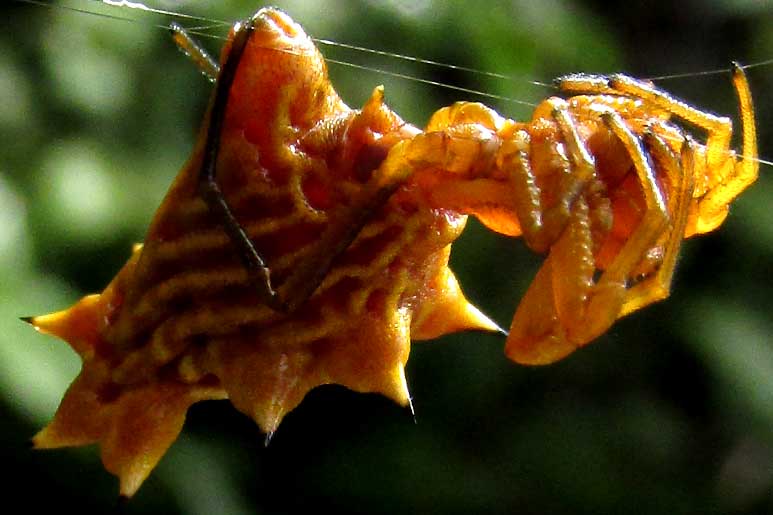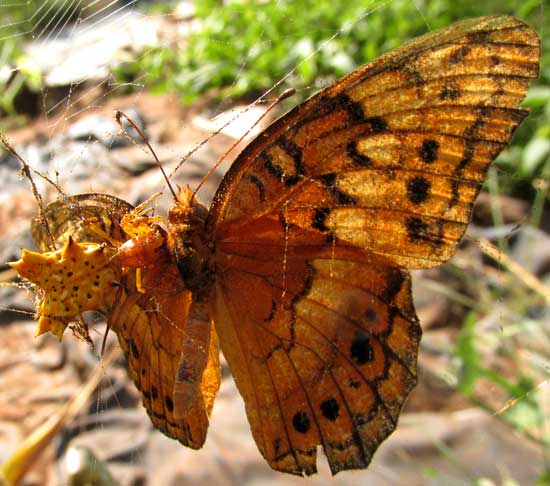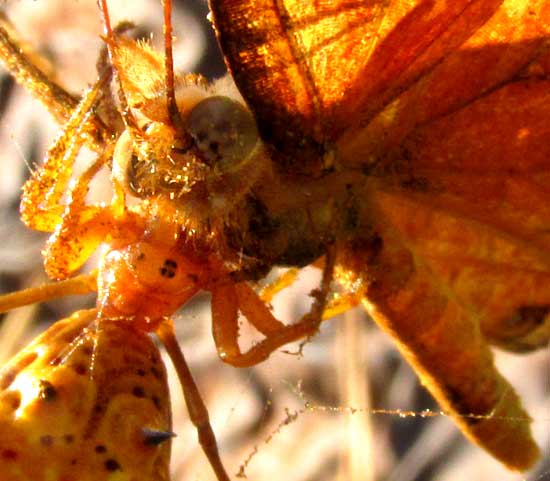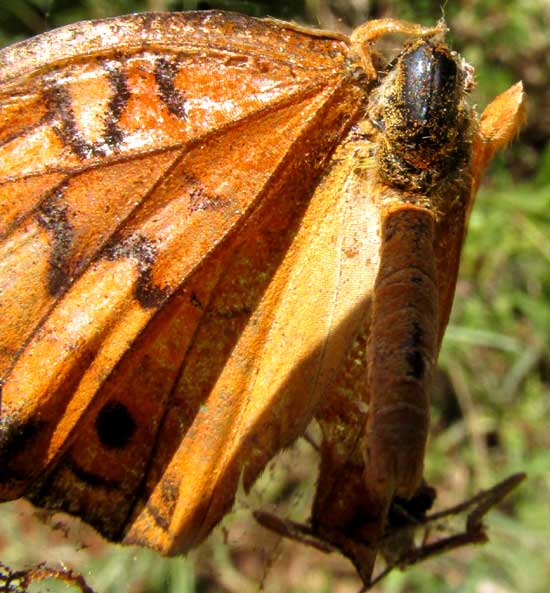Excerpts from Jim Conrad's
Naturalist Newsletter

from the December 13, 2015 Newsletter issued from Hacienda Chichen Resort beside Chichén Itzá Ruins, central Yucatán, MÉXICO
SPINED-MICRATHENA, GOLDEN MORPH
In eastern North America, if you're walking along a forest trail and run into a spider web strung across the path, there's a good chance that the web will have been constructed by the very common and distinctive Spined Micrathena spider. Spined Micrathenas are easy to recognize because their abdomen bear five conspicuous, broad-based spines, and all the ones I've seen are boldly patterned with black and white stripes and mottling. The tops of their abdomens are mostly white, with black spines.
This week a spider of the same size, shape and with the same patterning of the Spined Micrathena turned up weaving her web between the tips of a tufted agave plant, but this individual was orange/gold and yellow, not black and white. That's her above. As she hangs upside-down spinning out her web, the silken threads are produced atop the lobe on the abdomen's bottom -- directed skyward -- as seen below:

Spiders aren't the favorite subjects for volunteer identifier Bea in Ontario, and she couldn't be sure of her name, but she wrote back that our golden spider on the agave looked most like the Spined Micrathena, despite it not being black and white. When I checked out the matter, most Internet photos of the species do show black-and-white individuals, but a few are golden like ours, and the species' technical description says that certain morphs can be yellow-orange, so it looks like that's what we have.
The Spined Micrathena, MICRATHENA GRACILIS, is described at the Encyclopedia of Life (EOL) website as occupying dense deciduous forest in eastern North America, south through Mexico into Central America. Here our forest is only semi-deciduous, plus our spider spun on an agave along a weedy roadside, so in our area they show some habitat flexibility.
Up north often I've wondered why Spined Micrathenas were so boldly patterned, making them more visible. I guessed that it was to help low-flying birds and wandering mammals crossing the forest openings the webs tended to occupy to see the spider, and not crash through their webs. However, a paper by Natasha Vanderhoff and others addressed the very question of why Spined Micrathenas are so attention-getting. When they compared prey-capture rates of less brightly colored individuals with those of brighter ones, they found that the "... spiders’ color and pattern may attract prey items to their webs, thus increasing their foraging success."
I read that when the sun goes down Spined Micrathenas eat their webs, then build them again at dawn. Also, males, about half the size of females, don't build webs, but rather weave a "mating thread" onto the web of the female of their choice. When everything is in place, he quickly runs out and mates. Websites often report that the mating can be deadly for the male, but the EOL website says that "Sexual cannibalism appears to be rare in this species and has been observed only when two males courted a female simultaneously."
Spined Micrathenas are completely harmless to humans.
from the July 27, 2018 Newsletter issued from Rancho Regenesis in the woods ±4kms west of Ek Balam Ruins; elevation ~40m (~130 ft), N~20.876°, W~88.170°; central Yucatán, MÉXICO
FRITILLARY MEETS SPIDER
Each morning when I water the garden a good number of butterflies are attracted, for they like to perch on the ground basking as they suck up moisture loaded with the soil's minerals, or maybe a rainbow of nutrients in solution on wet burro turds used as fertilizer. It's good seeing so many butterflies flitting about, getting exactly what they're wanting.
One morning this week, however, a certain orangish Variegated Fritillary got caught in the web of a golden morph of the Spined Micrathena spider. Below, you can see what it looked like as the spider approached the frantically struggling butterfly, right before the spider bit it behind the head:

The moment when the spider's venom-injecting fangs pierced the butterfly's exoskeleton is shown below:

In that picture if you look closely, right below the fritillary's dark, rounded compound eyes, you can see the spider's two broad, elongated "jaws," or chelicerae, inserted into the golden fuzz behind the head. At the very bottom of the chelicerae the hidden fangs are injecting venom. Immediately below the chelicerae on the spider's "face," are four black points, which are eyes. Smaller eyes appear at the side.
I felt sorry for the fritillary, but also empathized with the spider's need to eat. It's just how Nature is set up, and I'm in no position to question the matter. About an hour after the last photo was taken, the fritillary had been reduced to a rather dry mummy, many of the wings' golden scales now dusting the butterfly's face, and the spider seems to have cut off the legs. Below, you can see the sad scene:
